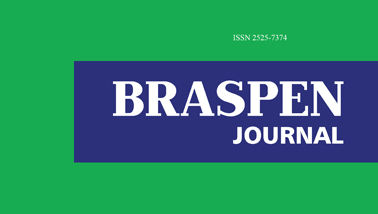Terapia nutricional enteral em uma Unidade de Terapia Intensiva: prescrição versus infusão
Enteral nutritional therapy on Intensive Therapy Unit: prescription versus infusion
Mayara Ribeiro de Mendonça, Gleyciane Guedes
Resumo
Introdução: Atualmente, a literatura sugere que a introdução precoce adequada da Terapia Nutricional Enteral (TNE) pode reduzir consideravelmente a incidência de infecções e o tempo de permanência hospitalar. No entanto, os pacientes em terapia intensiva frequentemente apresentam inadequações no suporte nutricional, tanto pela sub ou superestimação das necessidades energéticas diárias quanto pela introdução tardia da TNE e interrupções para procedimentos. Objetivos: Monitorar a adequação da TNE na unidade de terapia intensiva (UTI) visando à melhoria da qualidade da assistência nutricional, analisar a prescrição e o administrado de calorias e proteínas, verificar a adequação calórico-proteica entre o recomendado e o prescrito, identificar quaisas consequências dessa administração para o paciente, e observar quais fatores interferem para o adequado aporte na nutrição enteral. Método: Estudo documental, exploratório, em caráter quantitativo e qualitativo desenvolvido em uma UTI adulto no ano de 2017. Participaram da amostra pacientes acima de 18 anos com TNE exclusiva. Resultados: Foram analisados 22 pacientes internados na UTI de um hospital público do município de João Pessoa, PB, sendo 86% do sexo masculino e 14% do sexo feminino. A idade dos pacientes variou de 18 anos a 87 anos, com média de 51 anos. A quantidade média das proteínas recomendadas por pacientes no período foi superior aos percentuais ideais, porém, na adequação proteica entre a quantidade infundida e a prescrita, os valores ficaram aquém desses percentuais ideais. O percentual da média de adequação energética entre a infundida versus a prescrita ficou acima da recomendação, porém a maioria dos pacientes (86%) recebe uma quantidade aquém da recomendada. Sendo assim, tanto na adequação energética quanto em relação aos valores do aporte proteico há uma enorme disparidade entre a dieta infundida e a prescrita, sendo infundido ao paciente menos da metade do recomendado. A adequação do volume infundido também demonstrou estar abaixo da metade do recomendado. Conclusão: Os pacientes do hospital público de João Pessoa apresentaram déficit de ingestão calórica e proteica no período analisado.
Palavras-chave
Abstract
Introduction: Current literature data suggest that early introduction of Enteral Nutritional Therapy (NER) can significantly reduce the incidence of infections and length of hospital stay. However, intensive care patients often present inadequacies in nutritional support, either by sub- or overestimation of daily energy needs, by the late introduction of NER and discontinuation of procedures. Objectives: To monitor the adequacy of the NIC in the intensive care unit (ICU) aiming at improving the quality of nutritional assistance, analyzing the prescription and administration of calories and proteins, checking protein caloric adequacy between recommended and prescribed, identifying which consequences of this administration for the patient, to observe which factors interfere with the adequate intake in enteral nutrition. Methods: Quantitative and qualitative documentary exploratory study developed in an adult ICU in the year 2017. Patients above 18 years of age with exclusive enteral nutritional therapy participated in the study. Results: Twenty-two patients admitted to the ICU of a public hospital in the city of João Pessoa, PB, 86% male and 14% female. The patients’ ages ranged from 18 years to 87 years, with an average of 51 years. It was observed that the mean number of proteins recommended by patients in the period was higher than the ideal percentages, but in the protein adequacy between the infused quantity and the prescribed quantity the values are below these ideal percentages. The percentage of the average energy adequacy between the infused versus the prescribed one was above the recommendation, but the majority of the patients (86%) receive an amount less than recommended. Thus, both in energy adequacy and in relation to the values of protein intake there is a huge disparity between the infused and prescribed diet, and the patient is infused less than half of the recommended one. The adequacy of infused volume was also found to be below the recommended half. Conclusion: The patients of the public hospital of João Pessoa presented a deficit of caloric and protein intake during the analyzed period.

